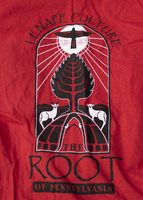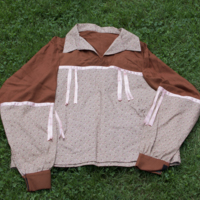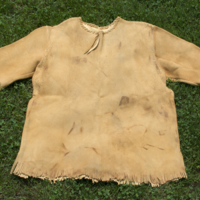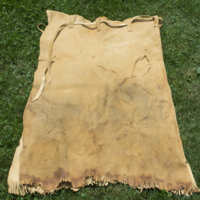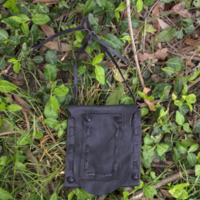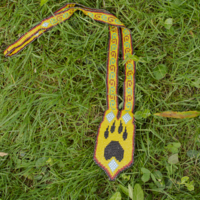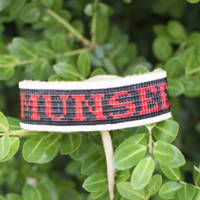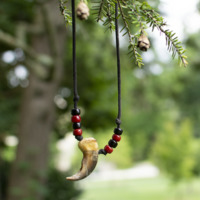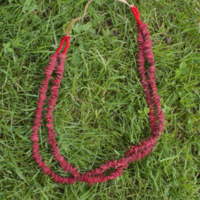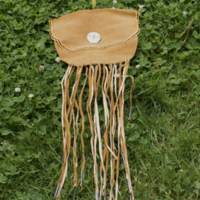Like Any Other, Like No Other: Clothing and the Lenape Nation of Pennsylvania
Lily Sweeney
Clothing, inseparable from our personalities, culture, and creativity, is always being reinterpreted as time changes.
“Traditional Indigenous dress” has become, in many ways, synonymous with regalia–ceremonial clothing worn for specific occasions and with some kind of historical precedent. The deerskin regalia and ribbon shirt presented here are all variations of "traditional" dress for the Lenape which will continue to evolve into the future.
Ceremonies don’t happen every day, however, and, in addition to regalia such as the ribbon shirt and deer skin ensembles, jeans, basketball shorts, and t-shirts like the one displayed below are as much the everyday wear of Indigenous people as they are for anyone else. Dominant trends are reinterpreted by the individual though, and symbols on jewelry or the design of the clothing, like the turtle which represents the Unami Clan of the Lenape, is one way people stay connected to traditional ideas.
Although LaBacz is not himself a member of the Nation, his work, including t-shirts like these, are sold at events and the Cultural Center. Money from the shirts cycles back into the Nation’s revitalization work. The design, first made in the form of a wood-cut print, was a collaboration between LaBacz and Jim Beer.
Ribbon shirts like these have become known as a sort of Pan-Indian attire, often worn by people of many Indigenous nations across the US as an intermediary between non-ceremonial dress and full-out regalia. The artist who made these shirts, Valara Hartman, is no longer able to make them due to limitations brought on by aging.
Deerskin regalia has deep historical roots in Lenape tradition. This set, a long shirt and wrap around skirt made of the traditional deerskin, was designed by Shelley Windamakwi DePaul. The firm contracted to make it by the Sigal Museum made numerous mistakes in the process including initially ignoring DePaul’s reference image and smearing something on the bottom of it without any input from DePaul, using common stereotypical designs from Western and Plains Native Americans that never existed in the Lenapehoking.
Like clothing, accessories adapt to suit identity in the present moment and to tell stories from the past. The medicine pouch below and Chief Redhawk’s beaded hat illustrate a mixing of past and present. The pouch was made using historical materials to hold a Nation member’s BIC lighter with an improvised design.
This cigarette pouch was a Christmas gift from the artist to her son. Constructed out of black-dyed deerskin, DePaul improvised the design using a technique of punching holes in the leather and weaving in other strips of leather to hold it together.
The hat, beaded by Chief Bob Redhawk Ruth, is worn for ceremonies or powwows. Items like these help the person wearing or using them come into the ceremony with the right mindset to facilitate their growth, healing, or accomplish another goal of the ceremony.
Both of these pieces, beaded by Philip Wakteme Rice, celebrate his connection to the Munsee clan of the Lenape, traditionally symbolized by the wolf. Jewelry like this is a way to proudly express one’s connection to the Nation even if one is wearing otherwise non-Lenape clothing.
These necklaces are made by a Tribal Council member and gifted to members on significant/spiritual occasions. Although Bear does have significance in Lenape culture (he is a teacher), it was Acevedo’s personal preference to make necklaces for significant occasions with bear claws.
Made in traditional Lenape design, this seed necklace has been in the Nation so long that the original creator has been forgotten. It has become a teaching tool in the hands of Shelly Windamakwi DePaul–who uses it to teach about traditional dyeing methods. Under the red dye are sunflower seeds, softened before being threaded together to make the necklace.
Medicine bags were one of the things that disappeared during the Lenape’s time of hiding. Today they are once again used to keep significant and sacred items. This medicine bag, whose design was found by DePaul online, is made of the traditional deerskin dyed black.
This beaded and fringed deerskin pouch, with an abalone button is meant to accompany one’s regalia. It can be used to hold tobacco, other herbs, or small ceremonial items.
In the next page, learn about the Lenape culture hero Meesing and contemporary adaptations to the yearly ceremonial tradition in his honor. Like with clothing, artists' individual skills, preferences, and personal relationships with cultural traditions shape their creations; the tradition grows through reinterpretation, rather than static replication.
